Rocky Reefs: Rich Feeding in Cool Waters
Scalloped Hammerhead Shark
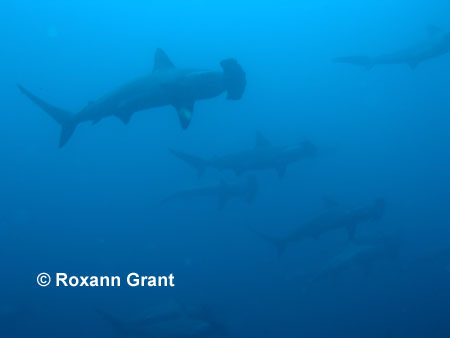
Although schooling has been reported in many shark species, none can match the social complexity of the Scalloped Hammerhead (Sphyrna lewini). In addition to exhibiting a sophisticated form of body language, this species demonstrates astonishing navigation skills, well-defined nursery areas, and an ability that no one expected sharks might share with humans.
Just the Facts:
Size:
Reproduction:
Diet:
Habitat: Intertidal, Estuaries, Sandy Plains, Rocky Reefs, Coral Reefs, Deep Sea Depth: intertidal - 1,400 ft (431 m) Distribution: Central Pacific, South Pacific, Tropical Eastern Pacific, Chilean, Western North Atlantic, Caribbean, Amazonian, Eastern North Atlantic/Mediterranean?, West African, Southern African, Madagascaran, Arabian, Indian, South East Asian, Western Australian, Northern Australian, Japanese |
To a diver, few sights are more breathtaking than a school of several hundred Scalloped Hammerheads soaring overhead in stately parade. Silhouetted against an electric blue sunburst, they are almost indescribably beautiful. Its members oriented alike and evenly spaced, the polarized school glides majestically through an azure dome of liquid sky, resembling a slow-motion armada of piscine angels with wing-like heads. Despite their apparently calm disposition, schooling Hammerheads are very skittish, driven to desperate flight by little more than a scuba diver’s exhalations. To observe schooling Scalloped Hammerheads, researchers and cinematographers must don closed-circuit rebreathers or free dive to some 70 or 80 feet (21 or 24 metres).
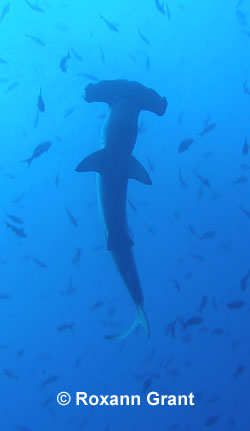
Schooling behavior of Scalloped Hammerhead Sharks has been most extensively studied in the Sea of Cortez. Here, during daylight hours, schools of 200 to 500 Scalloped Hammerheads congregate seasonally over seamounts. Their annual arrival coincides with the spring increase in surface water temperature and phytoplankton concentration. Telemetry tracking experiments have demonstrated that these Scalloped Hammerhead schools break up at night, their individual members apparently dispersing to feed in deeper offshore waters. At night, the sharks repeatedly ascend and descend in the depths, oscillating between 165 and 1 475 feet (50 and 450 metres). This may be a strategy for increasing the amount of water column searched for prey. Tracked individuals returned nightly to favored hunting grounds. At dawn, the Scalloped Hammerheads unerringly return to the tops of their respective seamounts, congregating once again at depths of 650 feet (200 metres) or less. In winter, when upwelling of deep-water masses cools the surface layers and reduces phytoplankton concentrations, the Scalloped Hammerhead schools disband until the spring. Where they go is a mystery.
How, in the overwhelming vastness of the Pacific, these Scalloped Hammerheads locate the seamounts each year is yet another mystery. But the movement patterns of individual sharks between their daytime haunts over seamounts and nocturnal feeding areas has been investigated, yielding a few secrets about the homing abilities of Scalloped Hammerheads. Environmental features such as subsurface light levels, current flow, temperature gradients, and bottom topography were all investigated and rejected as possible navigational cues used by the Hammerheads. One environmental cue, however, was found to closely match the precise paths that individual Scalloped Hammerheads use to navigate between their ‘home’ seamount and their night-time feeding grounds: steep gradients in the local geomagnetic signature. Measurements indicate that recently extruded magma from deep within the earth carries a magnetic signature up to three times more intense than that of the surrounding seabed. Individual Scalloped Hammerheads apparently migrate along these paths of locally enhanced geomagnetic field lines, using them as ‘magnetic highways’ to navigate between nocturnal feeding areas and daytime schooling grounds over their ‘home’ seamount. This represents the first demonstration of geomagnetic navigation by any shark in the wild.
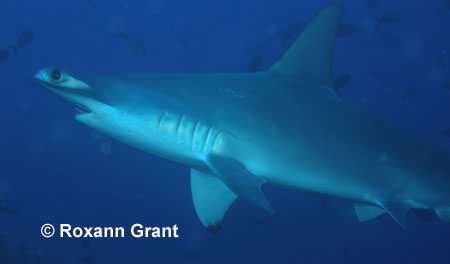
The schools of Scalloped Hammerheads in the Sea of Cortez are composed almost entirely of adolescent females. Males of the species remain in shallower inshore waters longer than the females and exploit different prey types. In the Sea of Cortez, male Scalloped Hammerheads 63 inches (160 centimetres) or longer feed primarily on a near-shore pelagic squid, Ancistrocheirus leseurii, and the Pacific Sierra (Scomberomorus scierra), while females of the same size-class feed primarily on offshore creatures, such as the squids Mastigoteuthis sp. and Moroteuthis robusta, as well as the pelagic fish known locally as the Dorado (Coryphaena hippurus). Due to their rich offshore feeding, female Scalloped Hammerheads grow faster than the males, which do not need to amass energy stores to nurture litters of young within their bodies. Since these large sharks have few predators, it is likely that the females’ schooling over seamounts during daylight hours enables them to remain conveniently near their nocturnal feeding grounds, a behavior known as “refuging”.
These refuging schools of Scalloped Hammerheads are extremely active, bustling with complex social activity. The sharks use at least nine distinct displays to jockey for the prime social position at the center of the school. Larger females signal their dominance over smaller ones by striking them on the nape with the leading edge of their hammer or by swimming in an elaborate “corkscrewing” pattern, in which they perform a vertically oriented rotation around the body axis. Smaller females signal submission through accelerating away or shaking the hammer from side-to-side, then retreating to the periphery of the school. Males are rare in the schools, but are known to perform “torso thrusts”, in which the displaying shark tilts on its side and repeatedly arches its body into a pronounced S-shape. The meaning of this display is not yet clear from context, but may be revealed through further research.
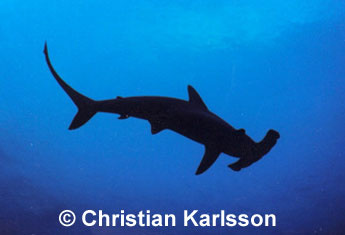 Scalloped Hammerhead Sharks are known to school in several other
locations around the globe. These include the Bahamas, Galapagos Islands,
Borneo, and in the Red Sea off Sudan. School structure in the Sudanese Red
Sea appears to be quite different from that studied in the Sea of Cortez,
featuring adults of both sexes at the periphery and juveniles concentrated
at the center of the school. This may be an adaptation to the relatively
greater risk of predation by other sharks in the Red Sea compared with the
Sea of Cortez, or may serve some other — as yet undetermined — function.
Further observations of schooling Hammerheads in the Red Sea and elsewhere
may shed some light on this intriguing matter.
Scalloped Hammerhead Sharks are known to school in several other
locations around the globe. These include the Bahamas, Galapagos Islands,
Borneo, and in the Red Sea off Sudan. School structure in the Sudanese Red
Sea appears to be quite different from that studied in the Sea of Cortez,
featuring adults of both sexes at the periphery and juveniles concentrated
at the center of the school. This may be an adaptation to the relatively
greater risk of predation by other sharks in the Red Sea compared with the
Sea of Cortez, or may serve some other — as yet undetermined — function.
Further observations of schooling Hammerheads in the Red Sea and elsewhere
may shed some light on this intriguing matter.
Early life history of Scalloped Hammerheads has long been studied on the windward shore of Oahu, Hawaii. Here, Kaneohe Bay is apparently an important nursery area for this species. Using dart tags, a classic study found that Scalloped Hammerhead pups are most abundant in the Bay between April and October. While in Kaneohe Bay, the pups remain in the most turbid water during the day, moving out of the bay at night to feed on reef fishes and crustaceans. Scalloped Hammerhead pups remain in the Bay for a maximum of three to four months, then depart nearshore areas and take up the more pelagic existence of adolescents and adults. It has been estimated that, each year, as many as 10,000 Scalloped Hammerhead pups may spend the earliest parts of their lives in the turbid waters of Kaneohe Bay.
A recent study of Scalloped Hammerhead pups in Kaneohe Bay confirmed and amplified the classic study, using telemetric tracking. All tagged shark pups showed high fidelity to a shared daytime core area just east of Coconut Island, to which they repeatedly returned after nocturnal foraging farther afield in the Bay and at nearby patch and fringing reefs. Nocturnal swimming speeds of these pups are typically greater than those exhibited during the day, suggesting they hunt actively under cover of darkness. During daylight hours, the Scalloped Hammerhead pups form a loose school that moves about within the core area, remaining about 5 feet (1.5 metres) above the sandy floor of the Bay. The pups undertake occasional short forays away from the core area during the daytime, but always return to home base before dusk. The small size of the total activity space utilized by the Scalloped Hammerhead pups at Kaneohe Bay suggests it provides a healthy foraging base for the growing sharks.
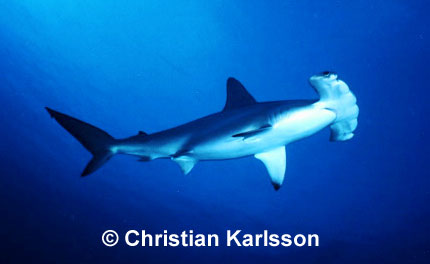
Scalloped Hammerhead pups held captive for research purposes in a shallow pond at Coconut Island often darken noticeably after a few days. The holding pond is only about 3 feet (1 metre) deep, its bottom experiencing levels of ultraviolet (UV) radiation some 600 times more intense than at the floor of Kaneohe Bay, which occurs at a depth of about 50 feet (15 metres). On a hunch, researchers placed UV-opaque filters on the pectoral fins of several Scalloped Hammerhead pups. Exposed parts of the pups’ skin — including the eyes — darkened significantly, but those under the filters did not. Histological examination of exposed skin samples showed greatly increased levels of the dark pigment melanin, while those from under the filters did not. In humans and a few other mammals, melanin is well known to protect the underlying skin by absorbing harmful UV radiation.
From these results, the researchers concluded that the pups were indeed ‘suntanning’, just like the throngs of human tourists visiting nearby Pearl Harbor. This is the first known case of tanning in any fish. Thus, the Scalloped Hammerhead joins a very select group of creatures — including pigs, rats, and humans — that respond to intense sunlight by tanning. The ability of Scalloped Hammerheads to protect their skin from harmful UV radiation while in shallow nursery areas is yet one more remarkable attribute of these amazing animals.
Scalloped Hammerhead Shark Bibliography
More about: Scalloped
Hammerhead FAQ
Origin and Evolution of the Hammer |
Hammerhead Taxonomy

